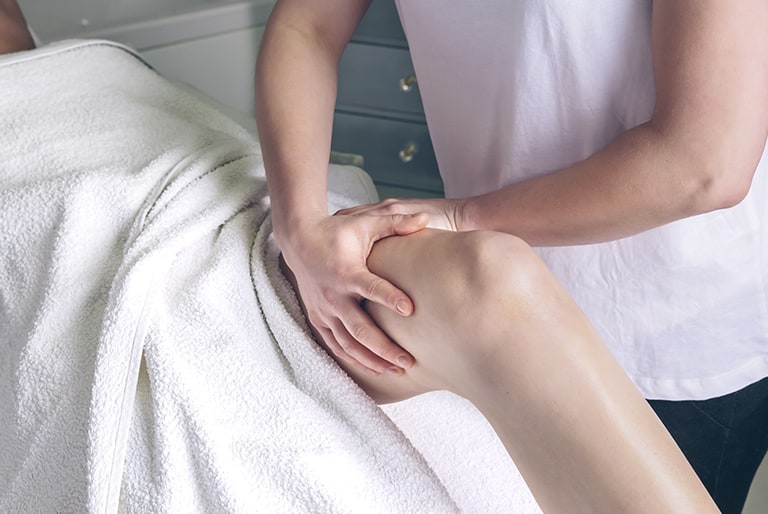Vein eradication (sclerotherapy)
Often a non-surgical method is used for varicose veins and spider veins: sclerotherapy. It is considered to be a really gentle way of treating varicose veins as it hardly produces pain, and patients are immediately mobile again. Large varicose veins are eradicated with so-called foam sclerotherapy.

What is sclerotherapy?
What exactly happens with sclerotherapy of varicose veins?
Spider veins and small varicose veins can be treated with the sclerosing agent Polidocanol in liquid form. Foam sclerotherapy is better suited for larger, also deeper-lying varicose veins e.g. trunk veins.
Vein sclerotherapy is an outpatient treatment without anaesthesia. Shortly before the treatment, the sclerosing agent is foamed up with air and then injected into the defective vein using ultrasound guidance. The foam pushes the blood out of the vein and immediately sticks the inner walls together. The great benefit is that the foam cannot get into the deep vein system. After about five minutes’ reaction time, the inner layer is destroyed and, ideally, the vein permanently sealed. With time, your body breaks down the foam and converts the vein scar into connective tissue. Immediately after the sclerotherapy, a surgical compression stocking is applied.Several sessions could be needed, depending on the form of the venous insufficiency, as for safety reasons only 10 ml volume of foam is allowed per session and day.
What is important after vein sclerotherapy?
Patients should move immediately after the treatment in order to stimulate blood flow in their venous system. Compression stockings should be worn for 48 hours after the sclerotherapy.
Following that, it is recommended to wear the stockings during the day for some time afterwards, in order to ensure the permanent adhesion of the inner walls and the complete absorption of the treated veins. For how long is determined by the treating vascular doctor, but with larger varices long compression treatment is a decisive factor in the success of the treatment, according to studies. In addition to that, compression stockings reduce the risk of thrombosis.
After six weeks and after a year, the phlebologist performs a check-up to see if follow-up sclerotherapy is required.
How long does it take to heal after sclerotherapy?
Healing can take between one and three months and depends on the diameter of the varicose veins treated. Calluses may remain longer term after sclerotherapy of larger varicose veins, but they will disappear with time. Sometimes your skin above the treated vein goes brownish in colour, but these discolourations usually disappear by themselves within a few weeks.
What benefits does sclerotherapy have?
Sclerotherapy of varicose veins has certain benefits compared with other methods of treatment.
- The vein is not removed, only “disconnected”.
- There is no need for an anaesthetic.
- Treatment only lasts for around 20 minutes.
- Patients can move again straight away and can return to work.
- Pain and other side effects are rare.
Sclerotherapy of veins – what risks does the treatment entail?
Sclerotherapy is considered as very safe and harmless, but there are, however, risks and side effects.
- Small haematomas can develop as a result of the treatment.
- Occasionally infection can develop at the insertion points, or even wound-healing disorders.
- The risk of deep vein thrombosis amounts to less than one per cent.
- Occasionally temporary visual disorders or nerve malfunctions were observed.
- The treatment can trigger a headache attack with migraine patients.
- Occasionally allergic reactions occur to the sclerosing solution or the plaster.
Who is sclerotherapy therapy suitable for?
The phlebologist thoroughly examines the whole venous system in order to determine the extent of the disease. He specifies the best therapy following the diagnosis. In the case of severely expanded trunk veins, it may be necessary to have them surgically removed (vein stripping). Alternatively, the seldom-practised, vein-preserving CHIVA method or endovenous laser therapy can be used. Sclerotherapy is a gentle and effective method for removing small varicose veins as well as pronounced spider veins, and it is frequently used.
Is the cost of sclerotherapy covered by health insurance funds?
Foam sclerotherapy is only covered by private health insurers. Statutory insured patients usually have to cover the cost themselves. It is best to ask your health insurance fund before the treatment.


